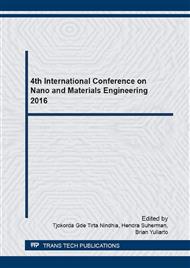p.112
p.117
p.123
p.128
p.134
p.143
p.149
p.154
p.159
Desorption of Arsenic Ions from Iron Modified Montmorillonite
Abstract:
Adsorption of metal ions proves to be an effective method in treating wastewater due to its simplicity and flexibility in terms of processing. Particularly, iron-modified montmorillonite (Fe-MMT) has been used to treat arsenic ion contamination. However, the strength of association of the metal ion with the adsorbent has not yet been fully explored. This study aimed to determine the stability of the attachment of As2+ onto Fe-MMT by performing desorption experiments using HCl and EDTA as eluents.The Fe-MMT was synthesized via ion exchange while the adsorption and desorption experiments were performed using a batch set-up. Conditions for adsorption were set constant, while the eluent type and concentration (0.1 M and 0.01 M) were varied during desorption. Arsenic ion concentrations were determined using ICP-OES. SEM images and FTIR spectra of the Fe-MMT were also obtained before and after adsorption-desorption steps. Highest desorptions among the settings were observed in 0.1 M HCl and 0.01 M EDTA with 36.72% and 37.13% desorption capacities, respectively. Since the pH conditions also varied with the eluent type, desorption of As is feasible, though not highly efficient, in both acidic and basic conditions with ion exchange as the dominant mechanism. There is a preference in desorption at 0.1 M in HCl but at 0.01 M in EDTA. Furthermore, no significant change in the morphology was observed. The FTIR spectra showed that the absorbance of Fe-MMT after desorption remains in the same range as the absorbance after adsorption but had lost intensity of some of its peaks, indicating possible interactions with acid.
Info:
Periodical:
Pages:
134-139
Citation:
Online since:
August 2016
Keywords:
Price:
Сopyright:
© 2016 Trans Tech Publications Ltd. All Rights Reserved
Share:
Citation:


